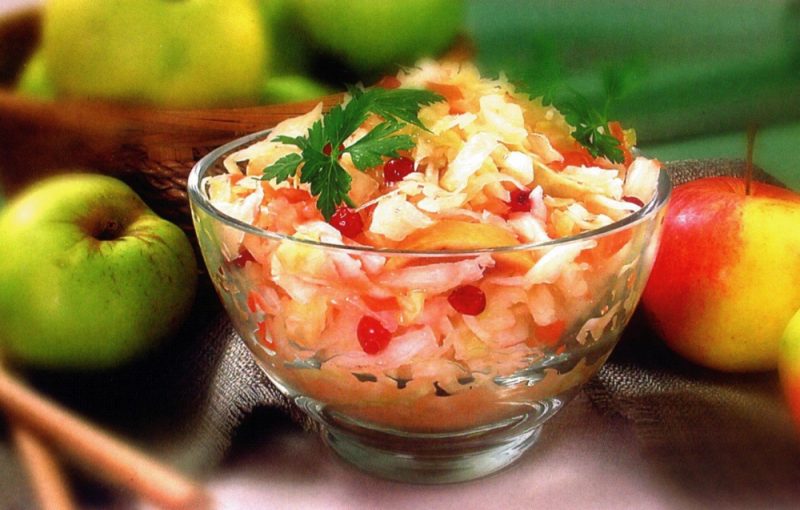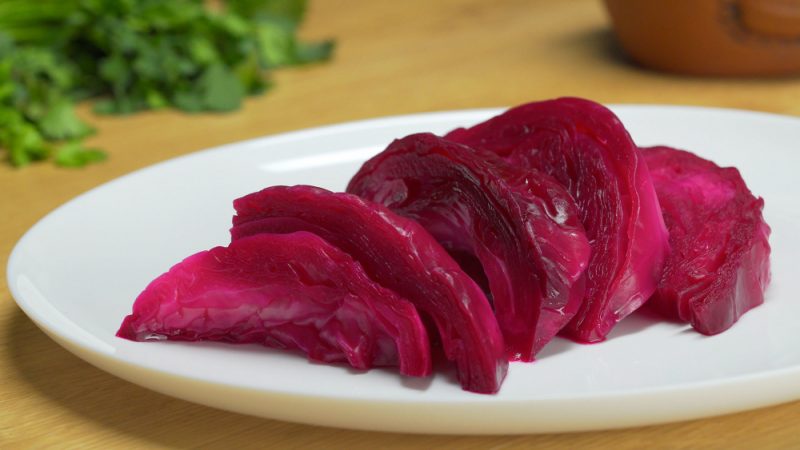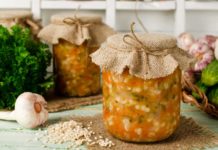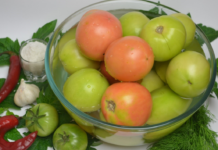Sauerkraut - at the mere mention of it, you probably drooled. Well, who does not like juicy, crisp, snow-white cabbage with fragrant sunflower oil and green onion? It’s good as an appetizer, excellent with boiled potatoes and will fit for the filling of the pie. In general, sauerkraut for the winter is the harvest that most housewives make. Moreover, today it is not at all necessary to salt it in huge barrels. It is enough to have a three-liter jar and a good recipe at hand.
Material Content:
Sauerkraut - a classic recipe
At present, by making an inquiry on the Internet on how to salt cabbage, you will get a million tips on slicing, salting, adding all kinds of ingredients up to vinegar and Korean gadgets. All this, most likely, will have little to do with real sauerkraut - that which is obtained only as a result of lactic acid fermentation, or fermentation. Everything else related to vinegar is not sauerkraut, although it is common and popular. We will talk about how to make Korean cabbage below. But true Russian cabbage is made without adding vinegar - this is the law!

So, what is sauerkraut - a classic recipe.
Of course, you can ferment cabbage at any time of the year, it is always on sale. But mass salting in Russia always began in late autumn, when the harvesting of this late vegetable was completed, and white cabbage (that's what we are talking about) was gaining the necessary sweetness, juiciness, amazing elasticity of huge white-headed cabbages.
That the cabbage was good, do not take immature and small heads of cabbage. The larger the head of cabbage, the more ripe, juicy.
The calculation is made from the presence of 10 kg of cabbage (you can reduce the rate by half or three in proportion to all ingredients).
So, prepare:
- 10 kg of cabbage;
- 200 g of coarse salt;
- a pound of carrots.
Important! Shredding cabbage for the winter in the villages was not just a tradition, but a kind of ritual. The thrifty housewives had for this purpose a special chopping board with a slot-blade in the middle, on which mountains of cabbage were shredded quite quickly. Setting the blade meant a lot: if you chop very thinly, the cabbage will be beautiful, juicy, presentable. It is sold in markets where long-term storage is not an issue. But if you plan to store the product for longer, then do not cut too thinly - it will quickly oxidize. And excessively thick strips are also not good - rammed, widely chopped cabbage will be poorly salted. Ideally - 3 mm wide or a little more.
Working process:
- We remove the top green and damaged leaves from the heads of cabbage.
- We cut into 4 parts, cutting out the stump, it is not needed.
- Cutting is done strictly across the growth of leaves, put a quarter on its side.
- We clean the carrots, rub on the largest grater (not Korean, but ordinary).
- On a large table we spread alternately a layer of cabbage, sprinkle with carrots and sprinkle with coarse salt. Important! This is best done on the table and with the entire volume of products at once. In this case, salt and carrots are distributed evenly. In addition, it is convenient to mix and grind the cabbage with your hands on the table, so that it gives juice more quickly. Do not be afraid to mash it, with proper preparation you will still have crisp cabbage.
- Fill a little grated cabbage in a 12-liter bucket. You can take a 10-liter, but juice can pour out from it during fermentation. To make everything fit, we ram the cabbage, introducing each new layer.
- On top of the cabbage we put a plate or flat lid upside down and put oppression on it. Previously, the oppression was a large stone, today you can pour a three-liter jar of water.
- Allow to stand for five days in a warm place until fermentation takes place.
About fermentation. First, cabbage quickly gives juice and sits down. The juice is light, transparent, but after three days it becomes cloudy - it goes fermentation with the release of gas bubbles. Many do not like cabbage for a specific flavor. But there will be no unpleasant smell if you give it a "breathe" in the process of fermentation. To do this, as soon as the juice is cloudy, on the third or fourth day they take out the cabbage in a cool place. For example, on the balcony, where they remove the load from the bucket and carefully pierce the layers to the bottom with a wooden stick or a long handle of a wooden spoon. The meaning of such manipulations is to release carbon dioxide, start the air to activate fermentation in the lowest cabbage layers.
After the fermentation (7-8 days), cabbage is transferred to the cellar or stored in the refrigerator, so as not to oxidize. If there is no cellar, then proportionately reduce the dosage of products and make for the refrigerator based on a smaller volume.
Apple Recipe
In principle, all the additional goodies can be put already in the prepared cabbage - for example, dill seed, caraway seeds. But many love cabbage with apples. Once the famous Antonovka was added to the whole cabbage, and the apples were vigorous, sweet and sour, crunchy from the cabbage. Now we do not allow ourselves such luxury - for the same reason that there is no cellar. But if you decide to make cabbage in a three-liter jar according to the above recipe, then why not shift a couple of layers into sliced pieces of peeled fresh apples? It will be great!
Cabbage sauerkraut
Choose the tightest heads of cabbage and the whitest. Vegetable must be of late variety. They are cut in quarters or, if not large cabbage, in halves. Stacked in a barrel or bucket, lining the bottom with green leaves removed from the heads of cabbage. The same leaves are placed on top.
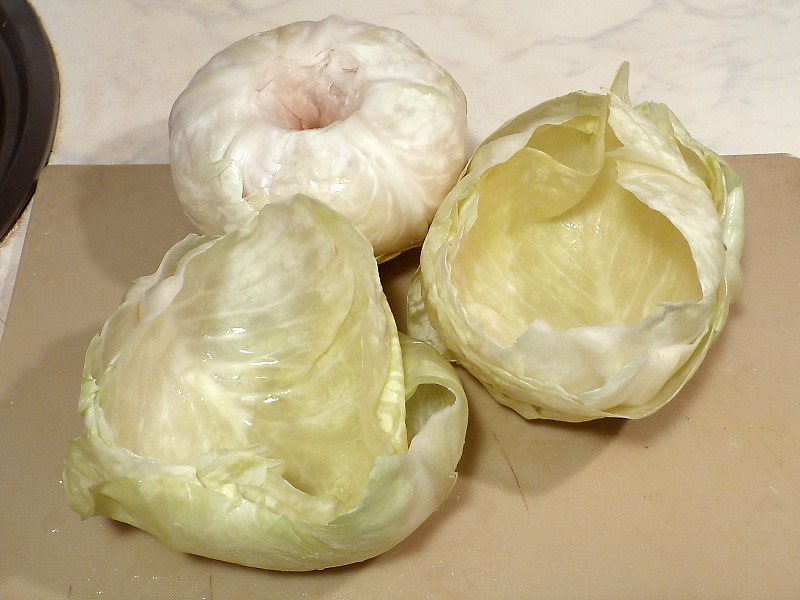
A linen napkin is laid out over the cabbage, a load is placed on it, after which everything needs to be filled with brine.
Brine - in a 10-liter bucket of water, 400 g of coarse rock salt.
If there is a barrel, then you can ferment both lump and slaw cabbage at the same time. For this, 10 kg of cabbage, 300 g of carrots, 200 g of salt are taken. First, slaw cabbage is laid in a layer of about 30 cm, then a layer of quarters of heads of cabbage is laid, cut again, and so on, until the barrel is full. It is important to mix slaw before bookmarks with grated carrots and grind with the entire volume of salt.
How to ferment cabbage in 3 liter jars?
Sauerkraut in a jar is also good.
The principle of preparation is the same, the recipe is as follows:
- 1 kg of shredded cabbage (2-2.3 kg of cabbage is usually placed in a jar, respectively, count other components);
- 100 g grated carrots:
- 20 g of salt.
Put the carrots and cabbage in a large dish, mix with salt and grind with your hands until juice forms. Put a layer of cabbage in a clean and dried jar, slightly condensing so that the juice rises. The juice will remain in the cup, but it must be preserved so that after topping up in a jar. Place a plate or cup under the jar to collect juice, which will boil during fermentation and flow out over the edge. This juice is also useful.
Important: To keep the juice flowing freely, close the jar with a lid with holes.
Keep cabbage in the room for a couple of days, at this time periodically pierce the contents of the can with a stick, so that the juice freely penetrates into all the cavities of the workpiece. If necessary, add juice to the brim. Another two days we keep the cabbage in the room, piercing with a stick, after which the cabbage can be taken out in the cold, having previously been taken inside. To do this, you can take a soft nylon cover and, folding it in half, put it in the neck and straighten. So the cabbage will always be under the juice and last longer.
Crispy and juicy sauerkraut
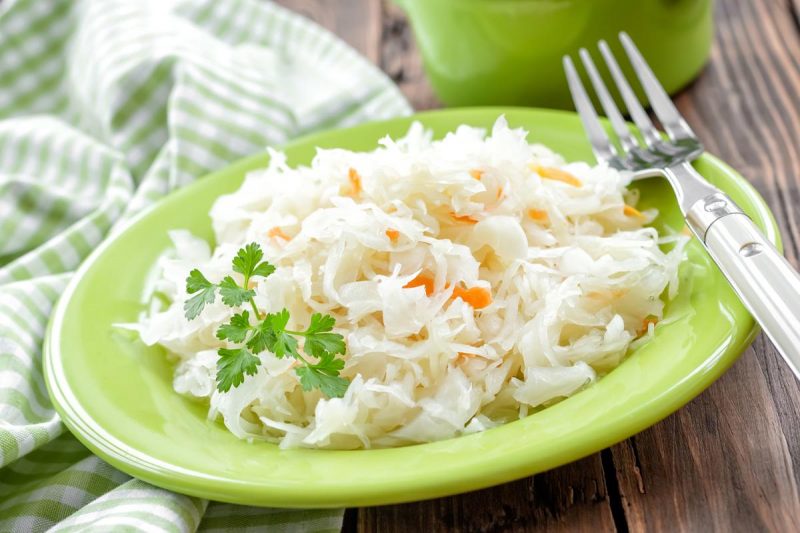
So that the cabbage comes out completely juicy, you can make it with brine. The brine consists of salt (2 tablespoons), sugar (2 tablespoons), one and a half liters of boiled water. Mix shredded cabbage with carrots, put into jars, slightly tamping, and pour brine (usually it takes 1.2-1.5 l on a jar). You can put bay leaf, peas of allspice and black pepper between layers of cabbage. Leave in a warm place. After a couple of days, the fermentation will pass, and the cabbage will be ready.
With beetroot, quick starter
It will not be possible to cook sauerkraut very quickly, unless vinegar is added to it. But since we are making a real pickled billet, then we will have to wait three days.
And you can make cabbage with beets like this:
- head of slaw;
- 1 medium beetroot;
- 1 carrot;
- 4 cloves of garlic;
- spices (peppercorns, bay leaf);
- 1.5 tbsp. l Sahara;
- 2.5 tbsp. l salts;
- 200 ml of water.
Cooking:
- From water, sugar, half the norm of salt we will prepare a brine, boil.
- Shred cabbage, carrots, beets, sprinkle with half the norm of salt and mix, grinding, to get the juice. Add spices and garlic, sliced.
- We tamp in banks and fill with the cooled brine. Hold for three days, periodically piercing the cabbage.
Korean for winter

In Korean, this is with a marinade:
- We cut one head of cabbage into a square, pour straws from two root crops of beets (medium-sized beets, shredded on a special grater for Korean salads).
- Add chopped onions (1 pc.) And 5 cloves of garlic, passed through a press.
- Mix everything and put in a pan or jar.
- We prepare the marinade: for a liter of water we take half a glass of sugar and vegetable oil, a couple of tbsp. tablespoons of salt, a bay leaf and peas of pepper, bitter and allspice. Boil, pour 40 ml of table vinegar and pour the vegetables with this brine. After 7 hours, the cabbage is ready. You can store it in the refrigerator.
Quick recipe in 2 hours
Quickly, almost instantly, you can pickle cabbage, if you need to catch dinner or guests on the doorstep. Of course, vinegar will not do here. We take a large head of cabbage and two large carrots. All finely shred and mix.
For the marinade in a liter of water, dilute a couple of tablespoons of salt, a glass of granulated sugar, boil. Then add half a glass of vegetable oil and 70 ml of table vinegar. Boil another five minutes, taste it. If the marinade is delicious, feel free to pour the cabbage. A couple of hours will not pass when you can try cabbage. Of course, it will not be quite pickled, but it will certainly be tasty.


